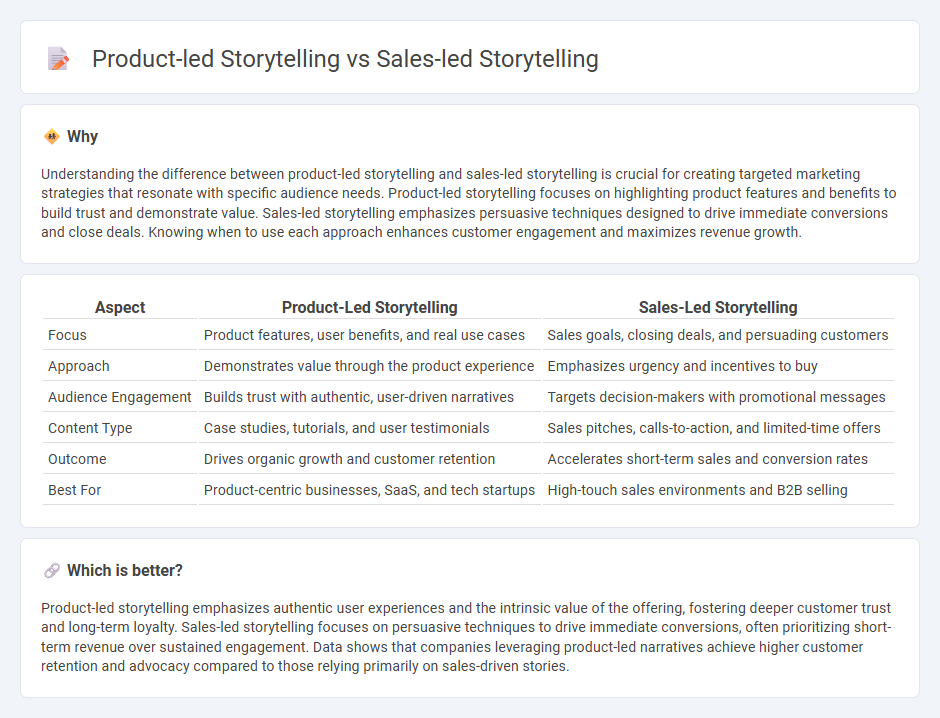
Product-led storytelling centers on showcasing a product's features, benefits, and unique value to build authentic customer engagement and drive organic growth. Sales-led storytelling focuses on persuasive narratives that emphasize closing deals by addressing pain points and offering tailored solutions. Discover how each approach can transform your marketing strategy and boost customer acquisition.
Why it is important
Understanding the difference between product-led storytelling and sales-led storytelling is crucial for creating targeted marketing strategies that resonate with specific audience needs. Product-led storytelling focuses on highlighting product features and benefits to build trust and demonstrate value. Sales-led storytelling emphasizes persuasive techniques designed to drive immediate conversions and close deals. Knowing when to use each approach enhances customer engagement and maximizes revenue growth.
Comparison Table
| Aspect | Product-Led Storytelling | Sales-Led Storytelling |
|---|---|---|
| Focus | Product features, user benefits, and real use cases | Sales goals, closing deals, and persuading customers |
| Approach | Demonstrates value through the product experience | Emphasizes urgency and incentives to buy |
| Audience Engagement | Builds trust with authentic, user-driven narratives | Targets decision-makers with promotional messages |
| Content Type | Case studies, tutorials, and user testimonials | Sales pitches, calls-to-action, and limited-time offers |
| Outcome | Drives organic growth and customer retention | Accelerates short-term sales and conversion rates |
| Best For | Product-centric businesses, SaaS, and tech startups | High-touch sales environments and B2B selling |
Which is better?
Product-led storytelling emphasizes authentic user experiences and the intrinsic value of the offering, fostering deeper customer trust and long-term loyalty. Sales-led storytelling focuses on persuasive techniques to drive immediate conversions, often prioritizing short-term revenue over sustained engagement. Data shows that companies leveraging product-led narratives achieve higher customer retention and advocacy compared to those relying primarily on sales-driven stories.
Connection
Product-led storytelling emphasizes showcasing the features and benefits of a product to create an emotional connection with the audience, while sales-led storytelling focuses on addressing customer pain points and driving conversions through persuasive narratives. Both approaches rely on clear, compelling messaging that highlights value propositions and customer-centric solutions. Integrating these methods enhances brand authenticity and accelerates the buyer's journey by aligning product capabilities with sales objectives.
Key Terms
Value Proposition
Sales-led storytelling emphasizes constructing narratives that highlight immediate benefits and drive customer actions through persuasive value propositions, targeting pain points to accelerate purchases. Product-led storytelling centers on demonstrating intrinsic product features and user experiences that naturally convey value, nurturing trust and long-term engagement without overt sales pressure. Explore detailed strategies to effectively balance sales-led and product-led storytelling approaches for optimal value proposition communication.
Customer Journey
Sales-led storytelling emphasizes persuasive narratives crafted around closing deals and driving immediate sales, focusing primarily on the buyer's decision-making stage. Product-led storytelling highlights the value, features, and benefits of the product itself, aiming to create engagement during the awareness and consideration phases of the customer journey. Explore how integrating both approaches can enhance customer experiences and accelerate conversions.
Product Experience
Sales-led storytelling emphasizes persuasive narratives designed to drive conversions by highlighting benefits, customer success stories, and value propositions. Product-led storytelling centers on showcasing the product experience itself through authentic interactions, user feedback, and demonstrable features that engage users directly. Discover more about how focusing on product experience can transform your storytelling strategy.
Source and External Links
The Ultimate Guide to Storytelling in Sales - MTD Sales Training - Sales-led storytelling builds trust by showcasing real-life results and using testimonials as stories, tapping into emotions to create bonds that make prospects more receptive to the sales message.
The Power of Storytelling: Transforming Your Sales Strategy for ... - Effective sales-led storytelling centers the customer as the hero, highlighting their challenges and successes to engage prospects and make the product relevant and appealing.
The Influential Power of Storytelling in Sales - Tailoring stories to align with the buyer's specific value drivers--business, experiential, aspirational, or personal--makes sales storytelling more influential by "speaking their language".
 dowidth.com
dowidth.com